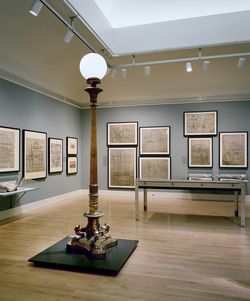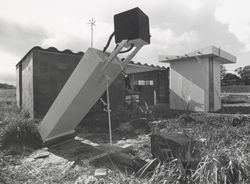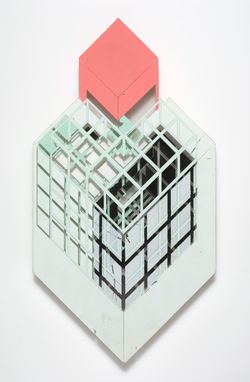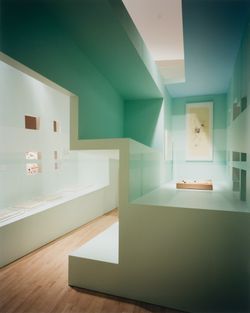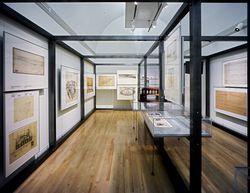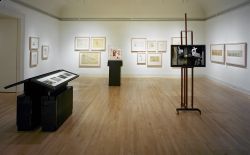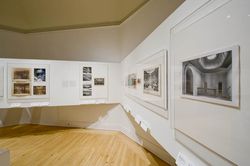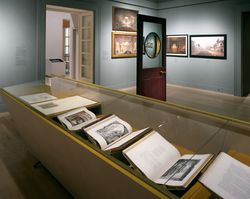This exhibition looks at the transformation of Montréal from a nineteenth century merchant city to the metropolis of Canada. It examines the elements that made Montréal a political, social, and economic centre and explores the unique character of its architecture. The exhibition brings together some 350 objects, including drawings from the CCA collection by Montréal(...)
Main galleries
18 March 1998 to 24 May 1998
Montréal Métropole, 1880–1930
Actions:
Description:
This exhibition looks at the transformation of Montréal from a nineteenth century merchant city to the metropolis of Canada. It examines the elements that made Montréal a political, social, and economic centre and explores the unique character of its architecture. The exhibition brings together some 350 objects, including drawings from the CCA collection by Montréal(...)
Main galleries
In the Yesterday Today lecture series, Canadian architect and author Witold Rybczynski discusses the roots of Ecol House, a prototype for an autonomous dwelling for use in developing countries. The project was created in Montréal in 1972 by Ecol Operation, a group of architects and students of which he was a member that became an international point of reference for(...)
Paul-Desmarais Theatre
29 November 2007
Witold Rybczynski: Green Before Green
Actions:
Description:
In the Yesterday Today lecture series, Canadian architect and author Witold Rybczynski discusses the roots of Ecol House, a prototype for an autonomous dwelling for use in developing countries. The project was created in Montréal in 1972 by Ecol Operation, a group of architects and students of which he was a member that became an international point of reference for(...)
Paul-Desmarais Theatre
Through the work of internationally renowned architects, this exhibition reveals the presence of utopian modernist ideas thought to have been discarded with the advent of the postmodern era. According to the exhibition’s lead curator Reinhold Martin, much of the architectural production of the last half-century has been haunted by the ghosts of modernist utopias: “The(...)
Octagonal gallery
28 February 2008 to 25 May 2008
Utopia's Ghost: Postmodernism Reconsidered
Actions:
Description:
Through the work of internationally renowned architects, this exhibition reveals the presence of utopian modernist ideas thought to have been discarded with the advent of the postmodern era. According to the exhibition’s lead curator Reinhold Martin, much of the architectural production of the last half-century has been haunted by the ghosts of modernist utopias: “The(...)
Octagonal gallery
The exhibition is an introduction to the work and life of Ernest Isbell Barott, a Montréal architect who practised from 1912 to 1966. The drawings and photographs in the exhibition are largely drawn from the Ernest Isbell Barott Archive at the CCA. Ernest Barott’s career coincided with a period of profound physical and social change in Canada, a time of national and civic(...)
1440 rue Sainte-Catherine Ouest
5 June 1985 to 6 September 1985
Ernest Isbell Barott, architecte/architect : une introduction/an introduction
Actions:
Description:
The exhibition is an introduction to the work and life of Ernest Isbell Barott, a Montréal architect who practised from 1912 to 1966. The drawings and photographs in the exhibition are largely drawn from the Ernest Isbell Barott Archive at the CCA. Ernest Barott’s career coincided with a period of profound physical and social change in Canada, a time of national and civic(...)
1440 rue Sainte-Catherine Ouest
*Cities of Artificial Excavation: The Work of Peter Eisenman, 1978–1988* explores how American architect and writer Peter Eisenman questioned the concept of “site,” and demonstrates the importance of drawing and modelmaking in generating his ideas. The exhibition reveals the richness and complexity of the design process by looking carefully at Eisenman’s drawings and(...)
Main galleries
2 March 1994 to 19 June 1994
Cities of Artificial Excavation: The Work of Peter Eisenman, 1978-1988
Actions:
Description:
*Cities of Artificial Excavation: The Work of Peter Eisenman, 1978–1988* explores how American architect and writer Peter Eisenman questioned the concept of “site,” and demonstrates the importance of drawing and modelmaking in generating his ideas. The exhibition reveals the richness and complexity of the design process by looking carefully at Eisenman’s drawings and(...)
Main galleries
Shaping the Great City explores the role of city-building throughout the Austro-Hungarian Empire, both before and after its dissolution, and expands architectural history by bringing to the fore a rich variety of modernisms. In the years surrounding World War I, these strains of modernism both reflected and shaped the many national and multinational identities of the(...)
Main galleries and hall cases
14 May 2000 to 15 October 2000
Shaping the Great City: Modern Architecture in Central Europe, 1890–1937
Actions:
Description:
Shaping the Great City explores the role of city-building throughout the Austro-Hungarian Empire, both before and after its dissolution, and expands architectural history by bringing to the fore a rich variety of modernisms. In the years surrounding World War I, these strains of modernism both reflected and shaped the many national and multinational identities of the(...)
Main galleries and hall cases
The exhibition addresses a central and timely aspect of the work of Carlo Scarpa: its distinctive approach to contending with the layers of history that mark the fabric of a city and a building. In addressing Scarpa’s ability to weave new work into, and often out of, the disparate fragments of the old, Carlo Scarpa, Architect: Intervening with History begins to unravel(...)
Main galleries
26 May 1999 to 31 October 1999
Carlo Scarpa, Architect: Intervening with History
Actions:
Description:
The exhibition addresses a central and timely aspect of the work of Carlo Scarpa: its distinctive approach to contending with the layers of history that mark the fabric of a city and a building. In addressing Scarpa’s ability to weave new work into, and often out of, the disparate fragments of the old, Carlo Scarpa, Architect: Intervening with History begins to unravel(...)
Main galleries
Toplight: Roof Transparencies from 1760 to 1960 traces the evolution of skylights from their origins at the end of the eighteenth century, when this type of fenestration was first explored in Paris’s new Halle au blé (1763–1782), to James Stirling’s History Faculty Building, University of Cambridge (1963–1968). The exhibition is organized around a series of case studies(...)
Octagonal gallery
23 October 2008 to 15 February 2009
Toplight: Roof Transparencies from 1760 to 1960
Actions:
Description:
Toplight: Roof Transparencies from 1760 to 1960 traces the evolution of skylights from their origins at the end of the eighteenth century, when this type of fenestration was first explored in Paris’s new Halle au blé (1763–1782), to James Stirling’s History Faculty Building, University of Cambridge (1963–1968). The exhibition is organized around a series of case studies(...)
Octagonal gallery
John Soane 1753-1837
Described by Henry James as “one of the most curious things in London,” Sir John Soane’s Museum was built as the picturesque and enigmatic home, office, collector’s trove, and personal showplace of one of history’s most innovative architects. This exhibition is a major re-evaluation of Soane’s career, as well as a reconsideration of his importance to the history of modern(...)
Main galleries
16 May 2001 to 3 September 2001
John Soane 1753-1837
Actions:
Description:
Described by Henry James as “one of the most curious things in London,” Sir John Soane’s Museum was built as the picturesque and enigmatic home, office, collector’s trove, and personal showplace of one of history’s most innovative architects. This exhibition is a major re-evaluation of Soane’s career, as well as a reconsideration of his importance to the history of modern(...)
Main galleries
exhibitions
Learning Architecture
As architecture acquired its modern identity as both a liberal art and a regulated profession, and as architectural theories and forms underwent radical transformations, the training of architects did not fundamentally change. The core activities of architectural students remain “Authority,” the study of treatises and theoretical works, “Observation,” the study of the(...)
Hall cases
5 July 1994 to 2 October 1994
Learning Architecture
Actions:
Description:
As architecture acquired its modern identity as both a liberal art and a regulated profession, and as architectural theories and forms underwent radical transformations, the training of architects did not fundamentally change. The core activities of architectural students remain “Authority,” the study of treatises and theoretical works, “Observation,” the study of the(...)
exhibitions
5 July 1994 to
2 October 1994
Hall cases
